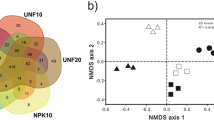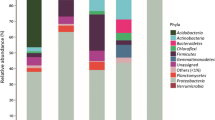Abstract
Studding the diversity of soil indigenous microorganisms, and monitoring effect of contaminants on microbial population, is very critical for understanding microbial activity during bioremediation and selecting successful remediation strategy. To simulate the natural environment, four microcosms were prepared by artificially contaminating clean soil with defined amounts of petroleum hydrocarbons including alkanes mixture (C13–C20), polyaromatic hydrocarbons (PAHs) mixture (anthracene, phenanthrene, fluoranthene, pyrene and benzo (α) pyrene) and both alkanes and PAHs. Contaminants degradation and heterotrophic bacterial count were measured during a 6-month study. Copy number of alkB and C23DO genes was studied using real-time PCR, and bacterial diversity was monitored by 16S rRNA gene PCR and denaturing gradient gel electrophoresis (DGGE). Results indicated that all types of contaminants (except the five ring benzo (α) pyrene) were totally degraded after 6 months and the increase in hydrocarbon degradation rate coincided with the enhancement of total heterotrophic bacterial count in each microcosm. Real-time PCR results showed a significant increase in the copy number of both alkB and C23DO genes in alkane- and PAHs-contaminated microcosm comparing with the control microcosm, indicating selection for special hydrocarbon degraders in hydrocarbon-amended microcosms. The results of DGGE revealed that the type of contaminant in the same soil has a remarkable influence on soil bacterial community structure. Sequencing of DGGE bands suggested that most of the dominant members of the microbial community of contaminated soil are unculturable bacteria from Proteobacteria and the genus Bacillus.






Similar content being viewed by others
References
Akbari A, Ghoshal S (2014) Pilot-scale bioremediation of a petroleum hydrocarbon-contaminated clayey soil from a sub-Arctic site. J Hazard Mater 280:595–602. https://doi.org/10.1016/j.jhazmat.2014.08.016
Altschup SF, Gish W, Miller W, Myers EW, Lipman DJ (1990) Basic local alignment search tool. J Mol Biol 215:403–410. https://doi.org/10.1016/S0022-2836(05)80360-2
Atlas RM (1981) Fate of oil from two major oil spills: role of microbial degradation in removing oil from the Amoco Cadiz and IXTOC I spills. Environ Int 5:33–38. https://doi.org/10.1016/0160-4120(81)90111-2
Baek KH, Yoon BD, Cho DH, Kim BH, Oh HM, Kim HS (2009) Monitoring bacterial population dynamics using real-time PCR during the bioremediation of crude-oil-contaminated soil. J Microbiol Biotechnol 19:339–345. https://doi.org/10.4014/jmb.0807.423
Bardgett, RD, De Vries FT, van der Putten WH (2017) Soil Biodiversity and ecosystem functioning. In: Microbial biomass: a paradigm shift in terrestrial biogeochemistry, pp. 119–140.
Beller HR, Kane SR, Legler TC, Alvarez PJ (2002) A real-time polymerase chain reaction method for monitoring anaerobic, hydrocarbon-degrading bacteria based on a catabolic gene. Environ Sci Technol 36:3977–3984. https://doi.org/10.1021/es025556w
Bordenave S, Goñi-Urriza MS, Caumette P, Duran R (2007) Effects of heavy fuel oil on the bacterial community structure of a pristine microbial mat. Appl Environ Microbiol 73:6089–6097. https://doi.org/10.1128/AEM.01352-07
Cole GM (2018) Assessment and remediation of petroleum contaminated sites. Taylor & Francis, New york
Das S, Kuppanan N, Channashettar VA, Lal B (2018). Remediation of oily sludge-and oil-contaminated soil from petroleum industry: recent developments and future prospects. In: Advances in soil microbiology: recent trends and future prospects. Springer, Singapore.
Dell’Anno A, Beolchini F, Rocchetti L, Luna GM, Danovaro R (2012) High bacterial biodiversity increases degradation performance of hydrocarbons during bioremediation of contaminated harbor marine sediments. Environ Pollut 167:85–92. https://doi.org/10.1016/j.envpol.2012.03.043
Greenwood PF, Wibrow S, George SJ, Tibbett M (2009) Hydrocarbon biodegradation and soil microbial community response to repeated oil exposure. Org Geochem 40:293–300. https://doi.org/10.1016/j.orggeochem.2008.12.009
Hadibarata T, Kristanti RA (2012) Fate and cometabolic degradation of benzo [a] pyrene by white-rot fungus Armillaria sp. F022. Bioresour Technol 107:314–318. https://doi.org/10.1016/j.biortech.2011.12.046
Hamamura N, Olson SH, Ward DM, Inskeep WP (2006) Microbial population dynamics associated with crude-oil biodegradation in diverse soils. Appl Environ Microbiol 72:6316–6324. https://doi.org/10.1128/AEM.01015-06
Hamamura N, Ward DM, Inskeep WP (2013) Effects of petroleum mixture types on soil bacterial population dynamics associated with the biodegradation of hydrocarbons in soil environments. FEMS Microbiol Ecol 85:168–178. https://doi.org/10.1111/1574-6941.12108
Hirsch PR, Mauchline TH, Clark IM (2010) Culture-independent molecular techniques for soil microbial ecology. Soil Biol Biochem 42:878–887. https://doi.org/10.1016/j.soilbio.2010.02.019
Ivshina IB, Kuyukina MS, Krivoruchko AV (2017) Hydrocarbon-Oxidizing bacteria and their potential in eco-biotechnology and bioremediation. In: Microbial resources. Academic Press, Cambridge, Massachusetts
Kirchman DL (2002) The ecology of Cytophaga–Flavobacteria in aquatic environments. FEMS Microbiol Ecol 39:91–100. https://doi.org/10.1111/j.1574-6941.2002.tb00910.x
Kuppusamy S, Thavamani P, Venkateswarlu K, Lee YB, Naidu R, Megharaj M (2017) Remediation approaches for polycyclic aromatic hydrocarbons (PAHs) contaminated soils: technological constraints, emerging trends and future directions. Chemosphere 168:944–968. https://doi.org/10.1016/j.chemosphere.2016.10.115
Lillis L, Clipson N, Doyle E (2010) Quantification of catechol dioxygenase gene expression in soil during degradation of 2,4-dichlorophenol. FEMS Microbiol Ecol 73:363–369. https://doi.org/10.1111/j.1574-6941.2010.00906.x
Liu Q, Tang J, Gao K, Gurav R, Giesy JP (2017a) Aerobic degradation of crude oil by microorganisms in soils from four geographic regions of China. Sci Rep 7:14856. https://doi.org/10.1038/s41598-017-14032-5
Liu SH, Zeng GM, Niu QY, Liu Y, Zhou L, Jiang LH, Tan XF, Xu P, Zhang C, Cheng M (2017b) Bioremediation mechanisms of combined pollution of PAHs and heavy metals by bacteria and fungi: a mini review. Bioresour Technol 224:25–33. https://doi.org/10.1016/j.biortech.2016.11.095
Liu Y, Ding A, Sun Y, Xia X, Zhang D (2018) Impacts of n-alkane concentration on soil bacterial community structure and alkane monooxygenase genes abundance during bioremediation processes. Front Environ Sci Eng 12:3. https://doi.org/10.1007/s11783-018-1064-5
MacNaughton SJ, Stephen JR, Venosa AD, Davis GA, Chang YJ, White DC (1999) Microbial population changes during bioremediation of an experimental oil spill. Appl Environ Microbiol 65:3566–3574
Margesin R, Schinner F (2001) Biodegradation and bioremediation of hydrocarbons in extreme environments. Appl Microbiol Biotechnol 56:650–663. https://doi.org/10.1007/s002530100701
Mesarch MB, Nakatsu CH, Nies L (2000) Development of catechol 2, 3-dioxygenase-specific primers for monitoring bioremediation by competitive quantitative PCR. Appl Environ Microbiol 66:678–683. https://doi.org/10.1128/AEM.66.2.678-683.2000
Morais D, Pylro V, Clark IM, Hirsch PR, Tótola MR (2016) Responses of microbial community from tropical pristine coastal soil to crude oil contamination. PeerJ 4:e1733. https://doi.org/10.7717/peerj.1733
Moser R, Stahl U (2001) Insights into the genetic diversity of initial dioxygenases from PAH-degrading bacteria. Appl Microbiol Biotechnol 55:609–618. https://doi.org/10.1007/s002530000489
Muangchinda C, Chavanich S, Viyakarn V, Watanabe K, Imura S, Vangnai AS, Pinyakong O (2015) Abundance and diversity of functional genes involved in the degradation of aromatic hydrocarbons in Antarctic soils and sediments around Syowa Station. Environ Sci Pollut Res 22:4725–4735. https://doi.org/10.1007/s11356-014-3721-y
Muckian L, Grant R, Doyle E, Clipson N (2007) Bacterial community structure in soils contaminated by polycyclic aromatic hydrocarbons. Chemosphere 68:1535–1541. https://doi.org/10.1016/j.chemosphere.2007.03.029
Muyzer G, De Waal EC, Uitterlinden AG (1993) Profiling of complex microbial populations by denaturing gradient gel electrophoresis analysis of polymerase chain reaction-amplified genes coding for 16S rRNA. Appl Environ Microbiol 59:695–700
Neilson JW, Jordan FL, Maier RM (2013) Analysis of artifacts suggests DGGE should not be used for quantitative diversity analysis. J Microbiol Methods 92:256–263. https://doi.org/10.1016/j.mimet.2012.12.021
Olapade AO (2015) Phylogenetic characterization and community diversity of hydrocarbon-utilizing bacteria in soil microcosms enriched with aromatic hydrocarbons. J Bioremed Biodegrad 6:305. https://doi.org/10.4172/2155-6199.1000305
Olivera NL, Esteves J, Commendatore MG (1997) Alkane biodegradation by a microbial community from contaminated sediments in Patagonia, Argentina. Int Biodeterior Biodegrad 40:75–79. https://doi.org/10.1016/S0964-8305(97)00065-6
Paisse S, Duran R, Coulon F, Goñi-Urriza M (2011) Are alkane hydroxylase genes (alkB) relevant to assess petroleum bioremediation processes in chronically polluted coastal sediments? Appl Microbiol Biotechnol 92:835–844
Perfumo A, Banat IM, Marchant R, Vezzulli L (2007) Thermally enhanced approaches for bioremediation of hydrocarbon-contaminated soils. Chemosphere 66:179–184. https://doi.org/10.1016/j.chemosphere.2006.05.006
Pfaffl MW (2001) A new mathematical model for relative quantification in real-time RT–PCR. Nucleic Acids Res 29:45. https://doi.org/10.1093/nar/29.9.e45
Powell SM, Ferguson SH, Bowman JP, Snape I (2006) Using real-time PCR to assess changes in the hydrocarbon-degrading microbial community in Antarctic soil during bioremediation. Microb Ecol 52:523–532. https://doi.org/10.1007/s00248-006-9131-z
Ringelberg DB, Talley JW, Perkins EJ, Tucker SG, Luthy RG, Bouwer EJ, Fredrickson HL (2001) Succession of phenotypic, genotypic, and metabolic community characteristics during in vitro bioslurry treatment of polycyclic aromatic hydrocarbon-contaminated sediments. Appl Environ Microbiol 67:1542–1550. https://doi.org/10.1128/AEM.67.4.1542-1550.2001
Robert K, Richard B, Samuel F (1997) Biodegradation of 14C benzo [a] pyrene added in crude oil to uncontaminated soil. Appl Environ Microbiol 63:4511–4515
Roy AS, Baruah R, Borah M, Singh AK, Boruah HPD, Saikia N, Deka M, Dutta N, Bora TC (2014) Bioremediation potential of native hydrocarbon degrading bacterial strains in crude oil contaminated soil under microcosm study. Int Biodeterior Biodegradation 94:79–89. https://doi.org/10.1016/j.ibiod.2014.03.024
Sánchez O, Gasol JM, Massana R, Mas J, Pedrós-Alió C (2007) Comparison of different denaturing gradient gel electrophoresis primer sets for the study of marine bacterioplankton communities. Appl Environ Microbiol 73:5962–5967. https://doi.org/10.1128/AEM.00817-07
Schulz S, Peréz-de-Mora A, Engel M, Munch JC, Schloter M (2010) A comparative study of most probable number (MPN)-PCR vs. real-time-PCR for the measurement of abundance and assessment of diversity of alkB homologous genes in soil. J Microbiol Methods 80:295–298. https://doi.org/10.1016/j.mimet.2010.01.005
Sei K, Inoue D, Wada K, Mori K, Ike M, Kohno T, Fujita M (2004) Monitoring behaviour of catabolic genes and change of microbial community structures in seawater microcosms during aromatic compound degradation. Water Res 38:4405–4414. https://doi.org/10.1016/j.watres.2004.08.028
Shabir G, Afzal M, Anwar F, Tahseen R, Khalid ZM (2008) Biodegradation of kerosene in soil by a mixed bacterial culture under different nutrient conditions. Int Biodeterior Biodegrad 61:161–166. https://doi.org/10.1016/j.ibiod.2007.06.003
Shahi A, Aydin S, Ince B, Ince O (2016) Evaluation of microbial population and functional genes during the bioremediation of petroleum-contaminated soil as an effective monitoring approach. Ecotoxicol Environ Saf 125:153–160
Singh P, Jain R, Srivastava N, Borthakur A, Pal D, Singh R, Madhav S, Srivastava P, Tiwary D, Mishra PK (2017) Current and emerging trends in bioremediation of petrochemical waste: a review. Crit Rev Environ Sci Technol. https://doi.org/10.1080/10643389.2017.1318616
Srivastava N, Gupta B, Gupta S, Danquah MK, Sarethy IP (2019) Analyzing Functional microbial diversity: an overview of techniques. In Microbial diversity in the genomic era. Academic Press, pp 79–102
Sutton S (2010) The most probable number method and its uses in enumeration, qualification, and validation. J Valid Technol 16:35–38
Tamura K, Dudley J, Nei M, Kumar S (2007) MEGA4: molecular evolutionary genetics analysis (MEGA) software version 4.0. Mol Biol Evol 24:1596–1599. https://doi.org/10.1093/molbev/msm092
Tanase AM, Ionescu R, Chiciudean I, Vassu T, Stoica I (2013) Characterization of hydrocarbon-degrading bacterial strains isolated from oil-polluted soil. Int Biodeterior Biodegrad 84:150–154. https://doi.org/10.1016/j.ibiod.2012.05.022
Vandecasteele JP (2008) Petroleum microbiology: concepts, environmental implications, industrial applications. Editions Technip, Paris
Vinas M, Sabaté J, Espuny MJ, Solanas AM (2005) Bacterial community dynamics and polycyclic aromatic hydrocarbon degradation during bioremediation of heavily creosote-contaminated soil. Appl Environ Microbiol 71:7008–7018. https://doi.org/10.1128/AEM.71.11.7008-7018.2005
Wang H, Wang C, Lin M, Sun X, Wang C, Hu X (2013) Phylogenetic diversity of bacterial communities associated with bioremediation of crude oil in microcosms. Int Biodeterior Biodegrad 85:400–406. https://doi.org/10.1016/j.ibiod.2013.07.015
Watanabe K, Hamamura N (2003) Molecular and physiological approaches to understanding the ecology of pollutant degradation. Curr Opin Biotechnol 14:289–295. https://doi.org/10.1016/S0958-1669(03)00059-4
Wu Y, Lai Q, Zhou Z, Qiao N, Liu C, Shao Z (2009) Alcanivorax hongdengensis sp. nov., an alkane-degrading bacterium isolated from surface seawater of the straits of Malacca and Singapore, producing a lipopeptide as its biosurfactant. Int J Syst Evol Microbiol 59:1474–1479. https://doi.org/10.1099/ijs.0.001552-0
Zamani S, Ghasemnezhad A, Ebrahimi S, Fathi M (2018) Evaluation the growth potential of artichoke (Synara scolymus L.) and Milk thistle (Sylibum marianum L.) in petroleum-contaminated Soil. J Chem Health Risks 8:39–50
Acknowledgments
The authors are grateful to Mr. Hassan Tirandaz for his contribution in microbial count analysis. The authors would like to thank Mr Vahid Samimi and Hadi Ghanbarnejad for their assistance in GC and HPLC analysis.
Funding
This research was funded by National Iranian Offshore Oil Company (IOOC) under contract Number 1-90-4386.
Author information
Authors and Affiliations
Corresponding author
Ethics declarations
Conflict of interest
The authors declare that they have no conflict of interest.
Human participants and animal rights
This article does not contain any studies with human participants or animals performed by any of the authors.
Additional information
Editorial responsibility: M. Abbaspour.
Rights and permissions
About this article
Cite this article
Khomarbaghi, Z., Shavandi, M., Amoozegar, M.A. et al. Bacterial community dynamics during bioremediation of alkane- and PAHs-contaminated soil of Siri island, Persian Gulf: a microcosm study. Int. J. Environ. Sci. Technol. 16, 7849–7860 (2019). https://doi.org/10.1007/s13762-018-02198-y
Received:
Revised:
Accepted:
Published:
Issue Date:
DOI: https://doi.org/10.1007/s13762-018-02198-y




